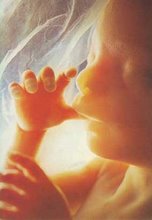Continued from Part I
A Theology of Despair
The Aztecs had a complicated mythology-theology. The universe for them was essentially unstable, and in that universe humans played a very small role. This view led to pessimism, and a fear that they needed to always appease the deities. Their view was that the present world was the "Fifth world," made by the "Feathered Serpent." The previous four worlds had been destroyed by gods who turned people into monkeys or dogs. The present world, they thought, would be destroyed by an earthquake, as a result of which skeleton creatures would come out of the ground to destroy the surviving inhabitants of earth.
This is a theology of despair. Whatever moral aversion they may have had to human sacrifice, their despair made them feel they had no choice but to practice it. The dynamics behind abortion are essentially the same. While there may not be a mythology of feathered serpents and skeletons, there is real despair. People do not get abortions because of "freedom of choice"; they get them because they feel they have no freedom and no choice. They feel trapped, abandoned, desperate, and afraid.
The thousands of case-studies that Priests for Life has collected from post-abortive women are permeated by the theme expressed by the woman who said, "My friends told me I had no other option. The clinic did not offer me any alternative, and I was almost crying out for one." As author Frederica Mathewes-Green has said, a woman does not choose an abortion like she chooses a Porsche or an ice-cream -- rather, she chooses it like an animal caught in a trap chooses to gnaw off its own leg. Her experience is that she either chooses to end the life of this baby, or her own life will end. "I cannot handle it, I can't do it, nobody will support me, it's impossible."
The rationalizations offered for abortion are also full of despair for the child. "Why bring a child into this world, into these circumstances, where he/she will have to suffer so much?"

Image via Wikipedia 18th Century painting of God Himself painting the Icon.
From Despair to Hope
How does the image of Our Lady of Guadalupe answer the theology of despair, both for the Aztecs and for the Americas?
Our Lady is carrying God within her womb. The God of the Universe has now become a human being. No longer is there any question as to whether God is on our side. He is not a God who will destroy us; He is a God who has become our brother. He is not a God far away who waits to be appeased by blood. He is a God who shares our own flesh and blood, and is as close to the human family as an unborn child to his mother.
In this framework, human beings no longer play a small part in the universe. On the contrary, as the Second Vatican Council proclaimed, "By his incarnation the Son of God has united himself in some fashion with every human being" (Pastoral Constitution on the Church in the Modern World Gaudium et Spes, 22). The result of that is the promise of Revelation 3:21, "I will give the victor the right to sit with me on my throne."
The universe into which Our Lady of Guadalupe invites us is no longer an unstable universe. God clearly reveals Himself as the only God, who is and shares both love and life. This truth brings hope. There is no longer need for human sacrifice, whether on pagan altars or in abortion clinics, because both the present and the future are in the hands of a God who is "God with us."
.jpg)
